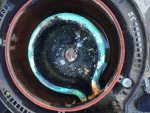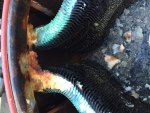This morning, December 31st, my pool heater heated it's last ounce of water. It's dead. After taking the thing apart with my pool guy he explained to me that the salt water pools corrode and then eventually cause a leak in the heating elements, then the tank fills up, and you get rust and ugliness (see attached ugliness). My heater was a Sta-Rite Max-E-Therm 400 HD, it's was only about 4 years old, and it seems like it should've lasted longer. I know I can just replace the heating element, but upon further investigation we could see that the saltwater was doing a number on a few of the parts. So instead of nickle and diming this back together, I'd rather just start over. I was wondering if anyone has had particularly good luck with a pool heater with a salt water pool. Keep in mind, I live in SoCal, my family likes the pool warm, so this thing pretty much runs 10 months out of the year (don't ask what my gas bills are, some things are better left unsaid).
I appreciate all the help and advice.
Lloyd


I appreciate all the help and advice.
Lloyd




